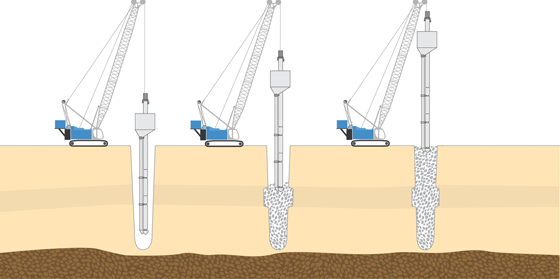Installation of stone column improves ground by reducing soil settlement. Due to its higher modulus of elasticity than that of soil, it absorbs more load than soil and reduces overall settlement.
Since applied load distributes in between soil and stone column in the ratio of their stiffness, the load carrying capacity of soil also increases.
Stone aggregates are used to fill stone column. Water can easily pass into the stone column. So, stone column helps in excess pore water pressure mitigation and accelerates the consolidation process.
In this method, boring is done by displacing nearby soil. The soil is displaced laterally, due to which engineering property of soil gets change.
This technique can be performed in two methods
- Top feed method
- Bottom feed method
Bottom feed method
The percentage of fines is higher than 10-15% of the soil volume.
The soil collapse around the VibroSTA and the hole does not stay open during and after the perforation process.
Once the perforation process is terminated, the stones are discharged at the bottom of the VibroSTA tip through a stone tube that drives the gravel into the VibroSTA building the stone column from the bottom to the top of the designed depth. Preferred perforation fluid is compressed air.
- Crane suspended
- Excavator mounted
- Piling rig application

Top feed method
During and after the perforation process an annular space stays open around the VibroSTA and the gravel can be provided into the hole from the top.
The top feed stone columns are a vibro replacement technique recommended for cohesive saturated soils.
This technique consists in building and compacting in the ground columns made from coarse gravel, crushed stone or crushed aggregate, following a grid pattern previously determined by a test trial.
In the top feed method, the column is made with stones that are added from the ground surface into the hole created by the VibroSTA.
This method requires the use of same equipment as the vibro compaction suspended from a crane.
The backfill is compacted and pushed into the sides of the hole.The stone column is formed from bottom of the hole to the top.

